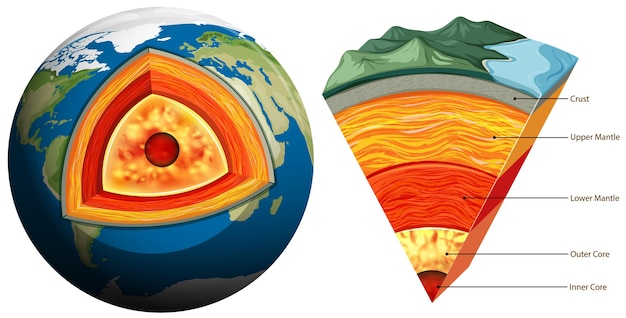

The Earth’s crust is the outermost layer of our planet.
The crust is made up of several tectonic plates that float on the semi-fluid layer beneath.
The Earth’s crust is constantly changing due to the movement of tectonic plates.
The crust is thinnest beneath the oceans and thickest beneath the mountain ranges.
The Earth’s crust is made up of various types of rocks, including igneous, sedimentary, and metamorphic.
The crust is home to numerous minerals that are essential for various industries and everyday life.
The Earth’s crust is not uniformly thick and can vary from a few kilometers to 70 kilometers in depth.
The crust is divided into two types: continental crust and oceanic crust.
The continental crust is thicker and less dense than the oceanic crust.
The oceanic crust is mainly composed of basalt, while the continental crust consists of granite and other rocks.
The Earth’s crust is composed of approximately 45% oxygen, 28% silicon, and 8% aluminum.
The crust is continuously formed through volcanic activity at divergent plate boundaries.
The crust is destroyed or recycled at convergent plate boundaries through subduction.
The Earth’s crust is home to numerous faults, such as the San Andreas Fault in California.
The crust contains various features, including mountains, valleys, canyons, and plains.
The crust is responsible for the formation of many natural resources, such as oil, gas, and coal.
The Earth’s crust holds valuable clues about the planet’s geological history and the evolution of life.
The crust experiences earthquakes and volcanic eruptions as a result of tectonic plate movement.
The crust is constantly eroded by wind, water, and ice, shaping its surface over time.
The Earth’s crust is where most of human civilization exists and thrives.
The crust is subject to constant stress and deformation as a result of plate tectonics.
The crust plays a crucial role in the Earth’s water cycle, affecting precipitation and runoff.
The Earth’s crust is about 30 kilometers thick on average.
The crust is thickest beneath mountain ranges like the Himalayas and the Andes.
The Earth’s crust is composed of around 90 different elements.
The crust contains minerals such as copper, iron, gold, and silver.
The crust’s chemical composition varies depending on its location and geological history.
The crust is divided into major and minor plates with distinct boundaries.
The Earth’s crust is estimated to be about 4.4 billion years old.
The crust is where most earthquakes occur, especially along plate boundaries.
The Earth’s crust is continuously changing due to volcanic activity and erosion.
The crust is the layer closest to the surface, making it accessible for scientific study and exploration.
The Earth’s crust is where we find the majority of the fossil record.
The crust is responsible for the formation of soil, a crucial resource for agriculture.
The Earth’s crust is divided into different regions with distinct geological characteristics.
The crust contains valuable resources that can be extracted through mining.
The Earth’s crust is home to diverse ecosystems, from deserts to forests to coral reefs.
The crust is affected by human activities, including deforestation and pollution.
The Earth’s crust is essential for maintaining the planet’s overall equilibrium and stability.
The crust is where we find the highest points on Earth, such as Mount Everest.
The crust plays a crucial role in supporting life by providing habitats and necessary resources.
The Earth’s crust is in a constant state of motion, albeit on a geological time scale.
The crust forms the boundary between the lithosphere and asthenosphere.
The crust is a complex and dynamic system that scientists are still studying and trying to understand fully.
The Earth’s crust is a testament to the planet’s extraordinary geological history and ongoing processes.
Around the world, coffee enthusiasts enjoy Monin coffee concentrate since it is a multipurpose product. Conveniently combining…
The Importance of Choosing the Right Shower for Your Bathroom Renovating your bathroom can be…
Usain Bolt holds the record for the fastest 100-meter sprint in history.Bolt was named Sportsman…
Love is in the air... and it smells suspiciously like chocolate!Roses are red, violets are…
Life's a beach, take a picture and relax.Sun, sand, and salty kisses. That's what beach…
Hungary is home to the largest thermal water cave system in the world.The Rubik's Cube…